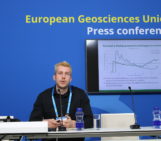Drawing inspiration from popular stories on our social media channels, as well as unique and quirky research news, this monthly column aims to bring you the best of the Earth and planetary sciences from around the web.
Major stories
The biggest story in Europe right now is the bone-chilling cold snap sweeping across the continent. This so-called ‘Beast from the East’ sharply contrasts with the Arctic’s concerningly warm weather. Scientists believe these warming events are related to the Arctic’s winter sea ice decline, which makes the region more vulnerable to warm intrusions from storms.

While a cold front covered most of Europe, warm air invaded the Arctic last week.
Credit: Climate Reanalyzer
However, we also wanted to highlight a couple of big stories from earlier in the month that may be less fresh in your memory.
Falcon Heavy
This month Elon Musk, the founder, CEO and lead designer of SpaceX, captivated a global audience when his company successfully launched the Falcon Heavy rocket from the Kennedy Space Center in Florida, USA.
The numbers associated with the rocket are staggering. SpaceX reported that the spacecraft’s 27 engines generated enough power to lift off 18 Boeing 747 ‘Jumbo Jets.’ The Falcon Heavy is currently the most powerful launch vehicle in operation and second only to the Saturn V rocket, which dispatched astronauts to the moon in the 1960s and 70s. The Guardian reports that the rocket “is designed to deliver a maximum payload to low-Earth orbit of 64 tonnes – the equivalent of putting five London double-decker buses in space.” Despite the rocket’s immense payload capacity, Musk opted to send just one passenger, a spacesuit-donned mannequin aptly named ‘Starman.’ The dummy sits aboard a cherry red Tesla Roadster with David Bowie tunes blasting from the speakers.
While Starman embarked on its celestial journey, two of the rocket’s three boosters successfully returned to the space centre unscathed via controlled burns. The third booster failed to land on its designated drone ship and instead crashed into the Atlantic Ocean at nearly 500 kilometers per hour.
SpaceX currently plans to fine-tune the Falcon Heavy and work on its successor, the Big Falcon Rocket, which Musk hopes could be used to shuttle humans to the Moon, Mars, or across the world in record time.
In a news report, BBC News listed some of the other possibilities that SpaceX could pursue with a rocket this size. Two of which include:
- “Large batches of satellites, such as those for Musk’s proposed constellation of thousands of spacecraft to deliver broadband across the globe.
- Bigger, more capable robots to go to the surface of Mars, or to visit the outer planets such as Jupiter and Saturn, and their moons.”
And what’s in store for Starman? Scientists estimate that the Tesla Roadster will orbit around the sun for millions of years, likely making close encounters with Earth, Venus, and Mars. They also report a small chance that the Tesla could face a planetary collision with either Earth (6 percent chance) or Venus (2.5 percent chance) in the next million years. However, even if the Tesla can escape collisions, it won’t be able to avoid radiation damage.
Cape Town’s water crisis
On 13 February South Africa declared Cape Town’s current water crisis a national disaster. Plagued by a three-year drought, the coastal city has been close to running out of water for some time, but this new announcement from government officials comes after reevaluating the “magnitude and severity” of drought. This reclassification means that the national government will now manage the crisis and relief efforts.
The declaration came a few weeks following Cape Town’s new water conservation measures, which limits individual water consumption to 50 litres a day. For comparison, residents from the UK use on average 150 litres of water per person daily. US citizens each consume on average more than 300 litres of water per day.
These new regulations, coupled with recent water use reductions and minor rainfall, will now push ’Day Zero,’ when Cape Town essentially runs out of water, from 12 April to 9 July. Day Zero more specifically marks the date in which the city’s primary water source, six feeder dams, is expected to drop below 13.5 percent capacity. At this level, the dams would be considered unusable and the government would cut off homes and businesses of tap water. Instead, the city’s four million residents would be forced to collect daily 25-litre water rations at one of the 200 designated pick-up points. If the city reaches this day, it would become the first modern city to run out of municipal water.
Scientists believe that Cape Town’s severe drought, considered the worst in over a century, is likely a result of Earth’s changing climate. In 2007 the Department of Water Affairs and Forestry warned that the area would likely experience hotter and drier seasons with more irregular rainfall due to climate change. However, experts note that the drought alone is not to blame for the national disaster. Poor water infrastructure, reluctance from the government to act on drought warnings, and inequality are also substantially responsible for the current crisis.
“What is now certain is that Cape Town will become a test case for what happens when climate change, extreme inequality, and partisan political dysfunction collide,” reports The Atlantic.

A dried up section of the Theewaterskloof dam near Cape Town, South Africa, on January 20, 2018. Credit: The Atlantic
In order to ‘Defeat Day Zero’ Cape Town officials hope to limit city water consumption to 450 million litres per day, but as of now residents use on average 526 million litres of water. In addition to promoting water conservation techniques, the city is also rushing to construct desalination plants, implement wastewater recycling, and drill into aquifers within the region. The latter initiative deeply concerns ecologists, who argue that depleting these groundwater resources would endanger dozens of endemic species and threaten the ecosystems unique diversity.
Other news stories of note
- Stemming the Plastic Tide: 10 Rivers Contribute Most of the Plastic in the Oceans
- The EU got less electricity from coal than renewables in 2017
- Melting ice could unleash hazardous waste from abandoned Cold War project
- Brussels to make public transport free on high air pollution days
- German court allows city ban on diesel cars
The EGU story
Early this month we issued a press release on research published in one of our open access journals. The new study reveals novel insights into Earth’s ozone layer.
“The ozone layer – which protects us from harmful ultraviolet radiation – is recovering at the poles, but unexpected decreases in part of the atmosphere may be preventing recovery at lower latitudes, new research has found. The new result, published today in the European Geosciences Union journal Atmospheric Chemistry and Physics, finds that the bottom part of the ozone layer at more populated latitudes is not recovering. The cause is currently unknown.”
This month also saw the online release of the 2018 General Assembly scientific programme, which lists nearly 1000 special scientific and interdisciplinary events as well as over 17,000 oral, PICO and poster sessions taking place at this year’s meeting. The EGU issued a statement stressing that all scientific presentations at the General Assembly have equal importance, independent of format.
And don’t forget! To stay abreast of all the EGU’s events and activities, from highlighting papers published in our open access journals to providing news relating to EGU’s scientific divisions and meetings, including the General Assembly, subscribe to receive our monthly newsletter.



